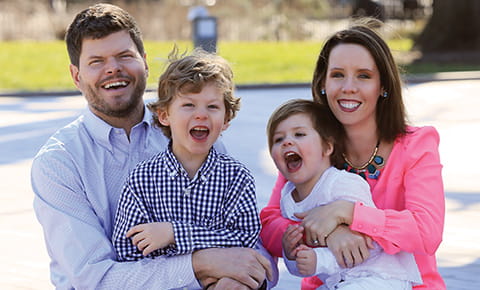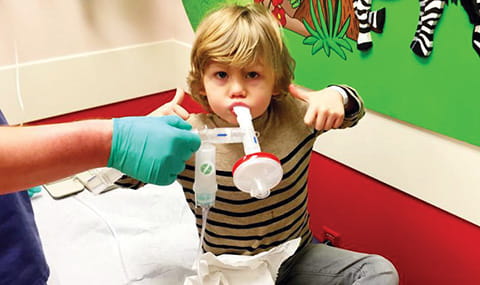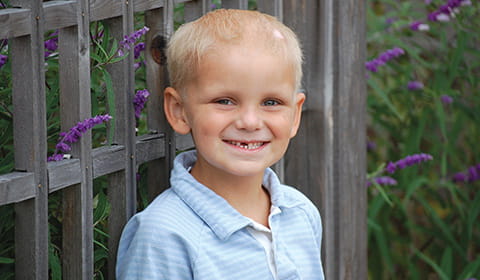Our Blueprint for a Cancer-free Future

Winn and Emilie knew something was wrong when their son Lachlan developed strange spots on his legs during a family vacation, but they never dreamed it would be cancer. They entrusted his care to the cancer experts at Cincinnati Children’s.
An Unforgettable Day
Lachlan, 6, edges into the room quietly. With his dark blond, slightly wild hair and vivid smile, it’s hard to imagine that he was ever sick. That his parents, Emilie and Winn, ever had to hear the words, “Your son has cancer.”
“We were vacationing when it happened,” Emilie remembers.
At the time, Lach was just like any other 18-month-old – energetic, curious and playful – and susceptible to typical childhood illnesses and injuries. That summer, he fought a respiratory infection, recurring ear infections, a fever and had an accidental fall in a creek, each requiring a different medication.
It was on that trip when Emilie noticed some peculiar spots on Lach’s legs. Called “petechiae,” these spots look like a rash and appear on the skin as a result of bleeding. They can be a sign of liver damage – something that was listed as a possible side effect on all of the medications he had recently taken.
Emilie and Winn took their son to the nearest emergency room. “He seemed so healthy, they tried to turn us away,” Emilie said. “But we insisted he get a blood test.”
After waiting for seven hours at the New York hospital, Lach finally got his blood test and their world turned upside down.
Leading the Way
While pediatric cancer is relatively rare, it’s still the leading cause of death from disease of children in the United States.
For the experts at Cincinnati Children’s, that’s simply unacceptable.
“Childhood cancer has a huge impact on families and our communities,” says John P. Perentesis, MD, FAAP, executive co-director, Cancer and Blood Diseases Institute (CBDI) at Cincinnati Children’s. “To put it in perspective, every time we cure a kid of cancer, we add an average of 71 years of productive life to that child.”
Care Second to None
For Winn and Emilie, the world stopped when the doctor told them that their son had acute lymphoblastic leukemia and needed to begin treatment immediately. “We researched hospitals and found out one of the best pediatric cancer centers was in our backyard.”

“For the three and a half years, Cincinnati Children’s was our second home,” Emilie smiles. “The care providers, all of the staff, were like a family to us. They still are.”
Even though he was going through intense treatments – chemotherapy, numerous spinal taps and bone marrow tests – Lachlan never lost his vivacious spirit. “He never once associated being at Cincinnati Children’s with something negative. It was the place that helped him, that cared for him, the place that took his pain away and made him feel better.
Making Science Count
It’s thanks in part to Perentesis’ vision and drive to cure all childhood cancers that Cincinnati Children’s is one of the largest referral centers for rare and relapsed cancers. In fact, many of the therapies used today around the world to fight childhood cancer were originally developed right here.
Thanks to those advances, now we can cure most children with cancer. But our goal is to cure all of them.
Enter CBDI’s Blueprint for the Future. Focused on investing in, expanding on and advancing research, the blueprint is designed to make science count for our patients in the most direct way – curing the diseases that threaten their lives.
Take, for instance, our groundbreaking work with engineered immune cells. This potential new treatment uses the patient’s own healthy immune cells and genetically alters them to fight the cancer. The studies of engineered immune cells are promising – 90 percent of patients with resistant cancers who have received this therapy have seen their cancer go into remission. Conventional therapies only offer 10 percent remission rates.
And that’s not the only way our researchers and clinicians are revolutionizing cancer care. “We’re taking advantage of the latest genomic technology to develop precision guided therapies, using each patient’s genome and avatars,” says Perentesis.
Using a biopsy of the patient's tumor, doctors isolate the genes that are driving the cancer. Then, clinicians will grow samples of the tumor in the lab to test various chemotherapy treatments.
By observing how the lab-grown cells respond, doctors can anticipate what the patient’s response could be and determine the most effective treatment. The potential of this groundbreaking research could save millions of children who are fighting high-risk, rare and relapsed cancers.
“The discoveries generated from this work will help us develop truly personalized treatments for each individual patient, increasing the chances for success,” Perentesis says.
Winning the Battle One Patient at a Time
 It was official – on November 4, 2014, three and a half years after the diagnosis, Lachlan was pronounced cancer-free and finished with chemotherapy treatments. “It was the best day of our lives,” Emilie’s voice grows quiet. “My son is a survivor.”
It was official – on November 4, 2014, three and a half years after the diagnosis, Lachlan was pronounced cancer-free and finished with chemotherapy treatments. “It was the best day of our lives,” Emilie’s voice grows quiet. “My son is a survivor.”
To give back to the place that saved Lachlan’s life, Emilie and Winn threw a “No Mo Chemo” party to raise money for childhood cancer research. “We wanted to do something to help sick kids in the future,” Winn says, clearing his throat.
“We wanted to give support to cancer research so that kids facing cancers with low success rates have the same chance my son did. If people didn’t donate in the past, our son wouldn’t be here today. We wanted to pay it forward and help save someone else’s son or daughter.”
“We value team science," Perentesis says. “And that team includes philanthropic partners. A lot of research is underfunded or unfunded, and donor support is vital to advancing care.”
Lachlan’s success story is visible proof of the difference research makes in the lives of kids with cancer. At Cincinnati Children’s, we take risks with bold new ideas that have transformational potential. “That pioneering spirit – connecting clinical care, research and philanthropy – is changing the game in pediatric cancer care,” says Perentesis. “When others have given up hope, we’re out there, finding cures, together.”
To support cancer research and care at Cincinnati Children’s, contact Kasey Fischesser at kasey.fischesser@cchmc.org or 513-636-4221.
Proton Therapy Offers New Hope

Since losing their son Tony to cancer, the Merk family hosts an annual 5K to honor his memory and to raise funds for pediatric brain tumor research. “It’s our way to still parent Tony, by adding good to the world in his name,” says Lynne Merk, Tony’s mom.
Cincinnati Children’s will soon become the second pediatric medical center in the nation with a Proton Therapy Center for patients with cancer.
Unlike conventional radiation therapy, proton therapy precisely targets the cancer, making treatment safer and more effective – especially for cancers that are difficult to treat, like brain tumors. Proton therapy also significantly reduces the risks of side and long-term effects caused by conventional treatments.
Our experts anticipate that proton therapy will replace conventional radiation for more than 80 percent of the children we treat – and it will provide new hope for kids with tumors that were previously thought to be untreatable.
“The Proton Therapy Center will improve treatment and advance discovery,” says Perentesis. “In fact, one section will be dedicated exclusively to research and development – the first of its kind in the world.”
This is welcome news to Rick and Lynne Merk who lost their son Tony to a rare brain tumor when he was just 6 years old. To honor their son, the Merks created the Pray-Hope-Believe Foundation (PHBF) to raise money for pediatric brain cancer research.
“We’re so pleased that research will play a big role in the Proton Therapy Center,” says Lynne. “We created PHBF in Tony’s memory – so cures can be found and so no other family has to go through what we did. We believe Cincinnati Children’s will help make that happen.”




